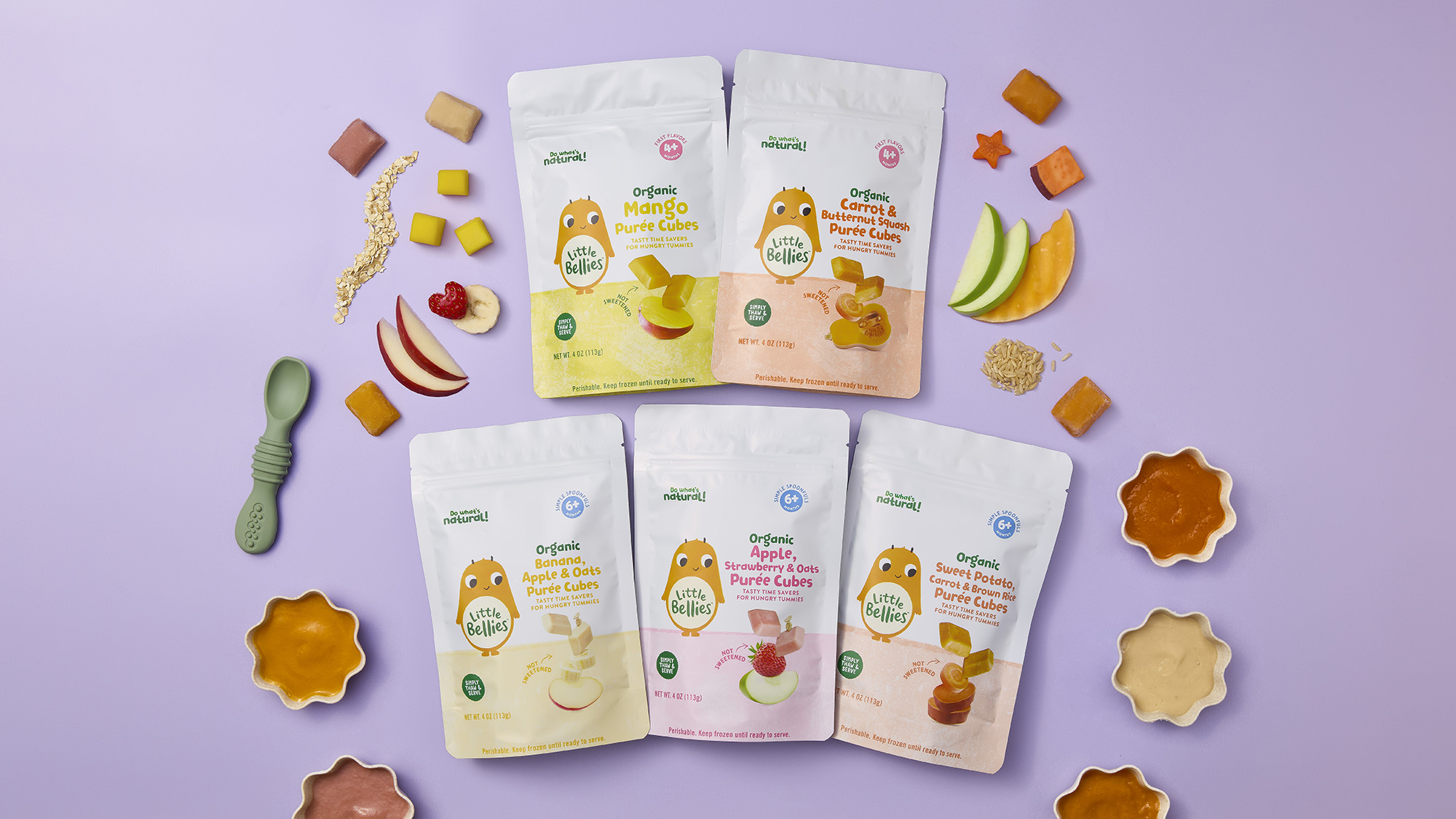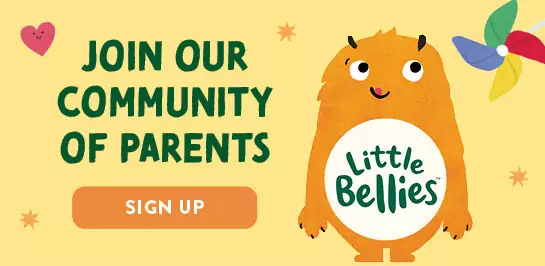How to make frozen teethers at home to soothe babies’ sore gums
Reading time:
Reading time:

Author: Jessica D’Argenio Waller, MS, CNS, LDN
Teething is one of the rare milestone moments in your baby’s first year that might elicit a few groans. Unlike those tentative first steps or sweet first words, as soon as those initial teething signs appear, you know that you and your baby are probably in for some sleepless nights and cranky days. That’s not for nothing: cutting teeth hurts and can make even the most happy-go-lucky little one irritable and fussy. As a parent, you might feel lost on how to help your tearful, teething baby. In the search to soothe those sore gums, you could turn to teething toys, but what if you could find a DIY solution that can offer relief from teething troubles – while also providing a nutrient-dense snack? For babies who have already started solids, using frozen baby food to make frozen teether pops are a simple yet effective remedy that can help soothe teething pain and keep the baby calm.
We’ll dig into the signs of teething (so you’ll know how to spot them at the outset), the general timing of teething in infants and how to make your own frozen teethers for babies to soothe those tender mouths — and your own fraying nerves.
Teething is the process of when a baby’s first set of teeth (known as baby teeth or primary teeth) emerge through their gums. During teething, your baby’s gums may become swollen, tender and sometimes painful as the teeth push through (ouch!). Teething usually continues until all 20 primary teeth have come through the gums, which happens well into toddlerhood – typically by age 3. Primary teeth are temporary and essentially serve as placeholders for the 32 permanent adult teeth. All those baby teeth will eventually fall out to make way for the bigger permanent adult teeth, which tends to begin around age 6.
While teething is a normal part of child development, it can be a trying time for both babies and parents, as it can lead to discomfort for your infant — and disrupted sleep as a result.
Because babies can’t fully communicate what they’re dealing with quite yet, it’s helpful to be able to spot the signs of teething so you can offer some relief.
In babies, signs of teething may include the following:
Excess saliva during teething can sometimes cause loose stools, but symptoms like watery diarrhea should be checked out by a medical professional.
Though some of the symptoms of teething can mimic those of a common cold or virus, vomiting is not associated with teething. Be sure to call your child’s pediatrician as vomiting can lead to dehydration.
In a word, teething feels uncomfortable. Tender, swollen and inflamed gums may cause a dull ache, and the inflammation may lead to a low fever, which can cause a feeling of general malaise for your infant. They may be more cranky than usual and have trouble falling or staying asleep at night because of the pain. Keeping bedtime consistent can be helpful here so as not to get too far out of routine. Be sure to soothe them with lots of extra snuggles and cuddles and comfort during this difficult time (and the natural remedies shared below) and know that it will soon pass.
Teething occurs in a few different stages as your baby’s teeth begin to push through the gums. Teething typically starts between 4 and 7 months of age, though it can start as early as 3 months. Here’s what to expect during each stage:
Before the first tooth emerges, you might notice signs such as increased drooling, irritability and a desire to chew on everything around them, including their hands.
This occurs when the first tiny teeth begin to break through the gums. The bottom front teeth (lower central incisors) are usually the first to appear, followed by the two top central teeth. While the timing of the first tooth eruption can vary, most typically it starts around 6 months and continues until around age 3 years.
In this stage, which typically occurs during your baby’s first year of life, several teeth may erupt at the same time. This, of course, can be a particularly challenging ride—fussiness, sleep challenges and clinginess may be the name of the game for this stretch. Remember to give lots of cuddles and safe teething relief options.
Once all the baby teeth have pushed through those little gums, including the molars, usually around age 3, most teething symptoms subside. But as little mouths adjust to all those new teeth, your toddler might still experience occasional discomfort.
Cold or frozen remedies can help ease painful aches and inflammation in your little one and provide a slight numbing effect. We’ve got the low-down on what to try. Remember: frozen foods are only a safe option for babies who have already started solids (usually over the age of 6 months).
Also good to note: before offering frozen teethers to your infant, which may be too cold straight from the freezer, let the frozen teether pop sit out for 2 to 3 minutes to warm up just a bit first.
Try using a damp washcloth (tie a knot in one end and twist when wet before freezing) that babies can comfortably gnaw on – ideal for infants under 6 months. Avoid teething rings that are frozen solid, AAP notes: they are too hard for children’s mouths.
These are great for babies who are still drinking breast milk or formula (regardless of whether they’re already eating solids). If you’re pumping and have some breast milk stored in the freezer, simply remove the milk storage bag from the block of frozen breast milk and offer the frozen milk for your baby to suck on, rubbing it gently over their tender gums. Try freezing prepared formula (a reusable popsicle or ice cube mold works well) for your formula-fed infant, too.
Frozen baby food purees made from vegetables and fruit are a great option to offer to a teething baby who has started solids. The slightly thawed frozen cubes can be added to a silicone mesh strainer and offered to your baby to mouth on. As the cubes melt further, they’ll make a soothing treat.
If you’re using a puree pouch, layer a small baking sheet with parchment paper, then use the pouch to squeeze out shapes with the puree onto the tray that will be easy for little hands to hold, like circles or straight lines, or even cute stars. Place the baking sheet in the freezer for the puree to harden for a few hours, then offer the frozen treats to your little one (ideally while wearing a bib!).
Because it’s cold and nutrient-dense (and sweet!), some types of frozen fruit can make a great DIY teething snack for babies who are already eating solids. Just be careful not to offer your baby anything too small that might present a choking hazard (like frozen berries, grapes or other bite-sized cut fruit). Instead, try making a frozen banana pop by sticking a popsicle stick into half a peeled banana (and then freezing it for a few hours), or freeze a spear or large triangle-shaped slice of watermelon or pineapple that’s big enough for your baby to hold onto and gently gnaw on.
Frozen cucumber sticks and sweet red pepper slices may also be good options if you’d like to go the veggie route for your teething baby. Note that raw carrots provide a higher choking risk. To avoid any potential choking hazards, always supervise your baby or toddler closely with any foods to prevent them from breaking off and swallowing any large pieces.
Check out our best fruit and veggie guides for every age and stage.
Dealing with teething can be tricky, but it doesn’t have to be a trying time. Extra snuggles, solid bedtime routines and making your baby frozen teethers can help reduce crankiness and soothe those sore gums – and hopefully, help you all sail through this season even stronger.
More insights on frozen baby food in our article The Benefits of Frozen Baby Food.

Let’s Make It Official
Get the latest news on parenting tips, food play hacks, promotions and giveaways!
Subscribe Now